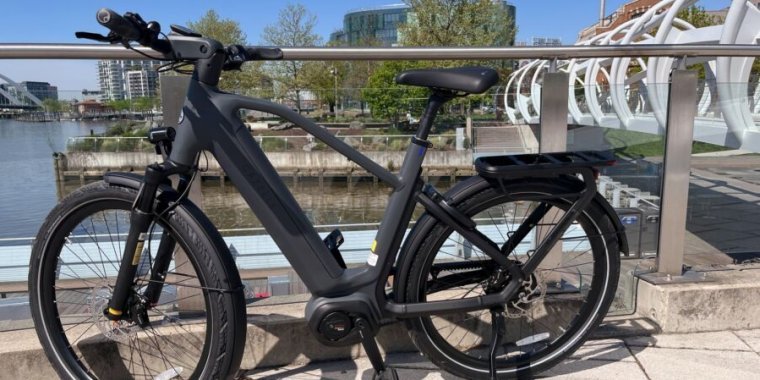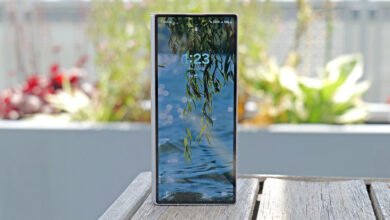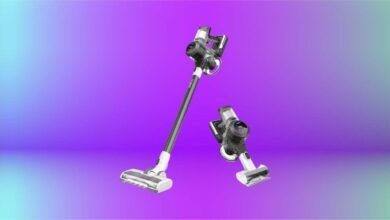Gazelle Eclipse C380+ e-bike review: A smart, smooth ride at a halting price

Kevin Purdy
Let me get three negative points about the Gazelle Eclipse out of the way first. First, it’s a 62-pound e-bike, so it’s tough to get moving without its battery. Second, its rack is a thick, non-standard size, so you might need new bags for it. Third—and this is the big one—with its $6,000 suggested retail price, it’s expensive, and you will probably feel nervous about locking it anywhere you don’t completely trust.
Apart from those issues, though, this e-bike is great fun. When I rode the Eclipse (the C380+ HMB version of it), I felt like Batman on a day off, or maybe Bruce Wayne doing reconnaissance as a bike enthusiast. The matte gray color, the black hardware, and the understated but impressively advanced tech certainly helped. But I felt prepared to handle anything that was thrown at me without having to think about it much. Brutally steep hills, poorly maintained gravel paths, curbs, stop lights, or friends trying to outrun me on their light road bikes—the Eclipse was ready.
It assists up to 28 miles per hour (i.e., Class 3) and provides up to 85 Nm of torque, and the front suspension absorbs shocks without shaking your grip confidence. It has integrated lights, the display can show you navigation while your phone is tucked away, and the automatic assist changing option balances your mechanical and battery levels, leaving you to just pedal and look.
-
The little shifter guy, who will take a few rides to get used to, is either really clever or overthinking it.
Kevin Purdy -
The Bosch Kiox 300 is the only screen I’ve had on an e-bike that I ever put time into customizing and optimizing.
Kevin Purdy -
The drivetrain on the C80+ is a remarkable thing, and it’s well-hidden inside matte aluminum.
Kevin Purdy -
The shocks on the Eclipse are well-tuned for rough roads, if not actual mountains. (The author is aware the headlamp was at an angle in this shot).
Kevin Purdy -
The electric assist changer on the left handlebar, and the little built-in bell that you always end up replacing on new e-bikes for something much louder.
Kevin Purdy
What kind of bike is this? A fun one.
The Eclipse comes in two main variants, the 11-speed, chain-and-derailleur model T11+ HMB and the stepless Enviolo hub and Gates Carbon belt-based C380+ HMB. Both come in three sizes (45, 50, and 55 cm), in one of two colors (Anthracite Grey, Thyme Green for the T11+, and Metallic Orange for the C380+), and with either a low-step or high-step version, the latter with a sloping top bar. Most e-bikes come in two sizes if you’re lucky, typically “Medium” and “Large,” and their suggested height spans are far too generous. The T11+ starts at $5,500 and the C380+ starts at $6,000.
The Eclipse’s posture is an “active” one, seemingly halfway between the upright Dutch style and a traditional road or flat-bar bike. It’s perfect for this kind of ride. The front shocks have a maximum of 75 mm of travel, which won’t impress your buddies riding real trails but will make gravel, dirt, wooden bridges, and woodland trails a potential. Everything about the Eclipse tells you to stop worrying about whether you have the right kind of bike for a ride and just start pedaling.
“But I’m really into exercise riding, and I need lots of metrics and data, during and after the ride,” I hear some of you straw people saying. That’s why the Eclipse has the Bosch Kiox 300, a center display that is, for an e-bike, remarkably readable, navigable, and informative. You can see your max and average speed, distance, which assist levels you spent time in, power output, cadence, and more. You can push navigation directions from Komoot or standard maps apps from your phone to the display, using Bosch’s Flow app. And, of course, you can connect to Strava.
Halfway between maximum efficiency and careless joyriding, the Eclipse offers a feature that I can only hope makes it down to cheaper e-bikes over time: automatic assist changing. Bikes that have both gears and motor assist levels can sometimes leave you guessing as to which one you should change when approaching a hill or starting from a dead stop. Set the Eclipse to automatic assist and you only have to worry about the right-hand grip shifter. There are no gear numbers; there is a little guy on a bike, and as you raise or lower the gearing, the road he’s approaching get steep or flat.
Source link




